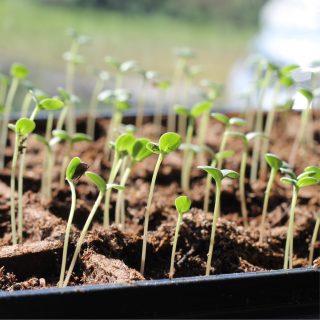Get a head start on your vegetable & flower gardens by starting your seeds indoors!
 Read seed packet for detailed planting information. Most importantly, pay attention to when to start your seeds indoors. Starting too early will give you leggy, weak plants. The approximate last frost date in our area is May 20th. If the seed packet says “sow indoors 4 weeks before average last frost date” then you will start that seed around April 20th.
Read seed packet for detailed planting information. Most importantly, pay attention to when to start your seeds indoors. Starting too early will give you leggy, weak plants. The approximate last frost date in our area is May 20th. If the seed packet says “sow indoors 4 weeks before average last frost date” then you will start that seed around April 20th.
Fill seed starting containers ¾ full with Bordine’s Potting Soil, which is a light airy mix. Make sure you have drainage holes.
Plant seeds at proper depth Cover loosely with soil.
Moisten with water Keep soil damp and warm, 80 degrees F, during the germination period.
After germination keep soil moist but not damp Try to keep the mix moist but not saturated.
After germination reduce temperature to 70 degrees F.
Give seedlings between 14-18 hours of light a day A sunny window is good but fluorescent grow lights are ideal.
Thin seedlings You want one seedling per pot, so choose the healthiest, strongest-looking seedling and snip off other seedlings at the soil line and discard them.
Start Fertilizing Weekly The first set of leaves that unfold are called cotyledons. All the food that’s needed to sustain these first leaves is contained right inside the seed. Once the second set of “true” leaves appear, you should begin feeding with Bordine’s All-Purpose 10-10-10 water soluble fertilizer.
After the last frost (usually around May 20th) gradually harden off seedlings outdoors. Start by moving the seedlings outside on warm sunny days making sure to bring in at night and gradually increase exposure. The seedlings will be ready to transplant in the garden after 2 weeks of hardening.
Vegetables that are great for indoor seed starting:
Broccoli, Brussels Sprouts, Cabbage, Cauliflower, Kale, Kohlrabi, Lettuce, Mustard Greens, Peas, Peppers, Radish, Spinach, Tomatoes & Herbs
